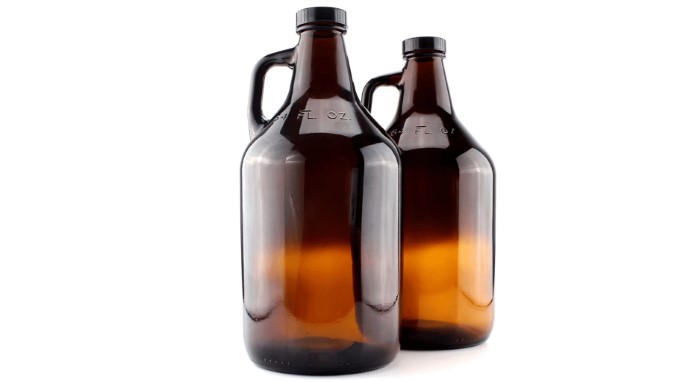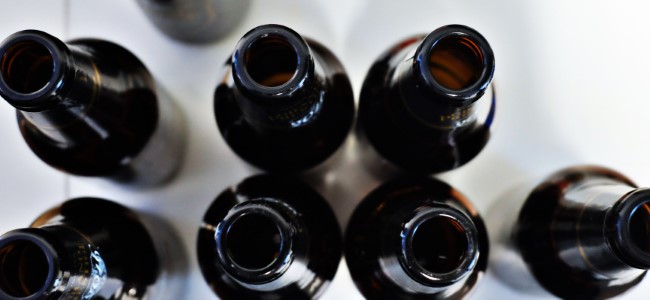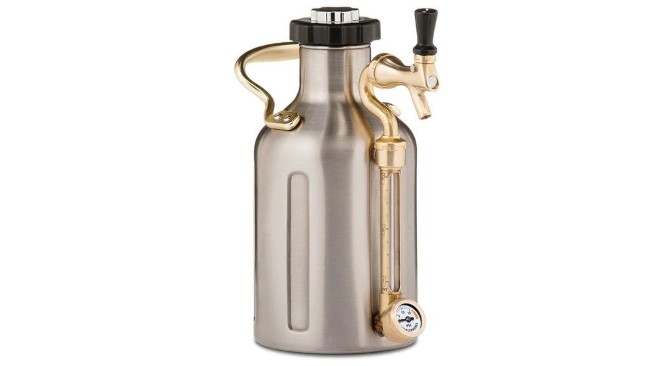The Archaic Era of the Beer Growler
Photo via Unsplash, Thomas Picauly
If you’re a drinker whose induction into the world of craft beer came fairly recently—say, in the last few years, or in what we’ll surely still be calling the “pandemic era” decades from now—then it’s entirely possible you’ll have no conception at all of the concept of the “beer growler.” Perhaps the newer beer geeks in the room have at least heard the term, but the chances of them actually possessing and regularly using 64 oz glass jugs to convey beer from the brewery to their home are slim indeed. Nor are they likely to have any inkling of just how omnipresent the beer growler was in American craft beer culture, a decade or so ago. Today, it’s a format that conjures both nostalgia and a certain disbelief—something akin to a collective “why did we all use these, again?” It’s safe to say the glass beer growler represents some now-passed moment in the growth of craft beer in this country, supplanted by changing brewery strategy and consumer preference, likely never to be seen again.
This isn’t exactly some new revelation, as the glass beer growler has been on its way out for a long time at this point, and various essays have been written eulogizing its place in the craft beer landscape since the late 2010s. But after seeing some online discussion of growlers recently, along with the fond memories and ardor of some fans who still apparently make use of them in various U.S. beer cities, I got to thinking about the growler as a concept: How we once used them, what they were good for, and their inherent drawbacks. Today, they’re immortalized as a symbol of the early 2000s-2010s craft beer boom, remnants of what many might see as a happier era before the challenges of the pandemic and a stagnating beer market. Their scion, the 32 oz “crowler,” on the other hand, continues to occupy a persistent niche in the beer world.
But for those newer beer geeks in the house, let’s answer the basic questions. Why were glass growlers so popular, once upon a time? And why did they then fade away?
The Appeal of the Beer Growler
One might lead off with the obvious question: Why did people ever fill growlers with beer, rather than just buy packaged beer? And there are a few reasons for this, which allowed the growler to become a ubiquitous beer accessory.
To start with, packaging beer is a very expensive undertaking, and it requires a large investment of resources for a small brewery to put in a bottling line or canning line. A decade or more ago, many of the breweries that have today become regional players were in their relative infancy, and some didn’t possess any in-house packaging at all. Rather, they sold their beer entirely through draft accounts, which there was notably less competition for than there is today. Mobile canning lines hadn’t really arrived as a concept, and affordable craft canning line systems were in their infancy. Growlers represented an opportunity for those breweries to send a customer who visited the brewery/taproom home with more or less “packaged” beer, even if they didn’t have a bottling or canning line.
Likewise, glass as a beer packaging material was far more attractive to the consumer a decade or more ago than it is today. Although craft cans were making big headway by the early 2010s, thanks to the pioneering efforts of breweries such as Oskar Blues in the early 2000s, many beer drinkers were slow to adopt craft beer in cans, and the perception of cans as “inferior” or taste-wrecking was very difficult to shake—after all, craft drinkers of the era had associated cans exclusively with cheap, domestic adjunct lagers all their lives. Bottles reigned supreme in the 2000s, including the large-format, almost entirely extinct 22 oz bottles we all referred to as “bombers,” and growlers were a natural spin off that were easy for the consumer to understand. It might be hard to imagine it now, but in the 2000s and early 2010s, many consumers simply associated brown glass with objective quality.
 The beer consumer’s preference for glass—or at least the perceived preference for glass—really did take a long time to shake.
The beer consumer’s preference for glass—or at least the perceived preference for glass—really did take a long time to shake.
Growlers of this era also could represent a solid value, depending on the brewery—they could be a way to sample a new beer that was more affordable than buying an entire six-pack, or a way for breweries to sell off older beer at a discount. Many breweries likewise instituted growlers into something akin to taproom “mug club” culture, offering memberships with cheap growler fills, or using growler fill discounts to get customers through the doors on slow nights of the week.
And finally, there was simply something very fun and communal about filling up a growler, bringing it to a party or get-together, and sharing the beer with friends. This is essentially the one thing that growlers were undeniably good for: Splitting with a few friends, as the 64 oz they contained was able to pour roughly 5 standard beers, or 4 glasses if you were using 16 oz shaker pints. And lord knows, a lot of us were in those days.
The Many Drawbacks of Growlers, And Their Demise
With that said, for as pleasant an experience as sharing a growler could be, the long list of disadvantages was always just as apparent to most industry observers.
On the most basic level, growlers simply didn’t work well as a storage vessel for beer, if the beer wasn’t going to be consumed promptly. Within a day or two of filling, they would invariably begin to lose significant carbonation and freshness, and they were particularly susceptible to UV light spoilage (skunking, sunstruck beer). Legendary Brooklyn Brewery Brewmaster Garrett Oliver memorably railed against them, comparing growler use to bringing restaurant food home to microwave it, while likewise making somewhat absurd claims such as saying that 30 seconds of sun exposure would ruin the contents of a growler. These were hyperbolic statements for sure, but he wasn’t wrong that beer from a growler is rarely that brewery’s beer at its best—the exposure to oxygen alone tended to start a process that gave them a very short lifespan.
Likewise, there was no shortage of physical annoyances to growlers—they’re heavy, they’re cumbersome, they’re very easily broken. Ever clean up 64 oz of beer from a pile of broken glass? It’s no picnic, and it limits the places where one could reasonably take or consume a growler as well.
In other words, growlers always possessed some physical issues, and unsurprisingly the temptation thus existed for tinkerers to improve or perfect them, but this drive typically just resulted in more expensive or needlessly complicated replacements that were no more functional than they object they were “improving” upon. The “innovation” side of the growler space had a tendency to be hopelessly stuffed with fanciful ideas that sounded more attractive in theory than they were in reality. Case in point: Something like the uKeg, an attractive and upscale growler concept that Paste actually did a giveaway for all the way back in 2016. Designed to hold the carbonation of the beer within and dispense it under pressure, the uKeg still retails for $150-200 online, even as the company eventually pivoted toward applying the same technology toward making nitro coffee, and eventually—of course—hard seltzer. My own uKeg? It broke the first or second time I used it, and was subsequently relegated to the back of a closet somewhere, never to see the light of day again. This was the fate suffered by practically every “improved” growler concept, as far as I can tell.
 You have to admit, it looked cool
You have to admit, it looked cool
It wasn’t just physical and practical issues that complicated the world of growlers, though—state law was also a thorny issue in many places. Some states simply disallowed the use of growlers for years or decades, legally labeling the bottles as essentially huge, single-serving drinks even though they were clearly intended to be shared. Various states approached growlers with a level of comical, nonsensical or outright prejudiced laws. Florida famously didn’t legalize the 64 oz glass growler until 2015, even though both 32 oz and 128 oz growlers had already been legal in the state for years. The culprit, of course, was the lobbying power of Big Beer, which typically sought to influence state legislatures into restricting the freedom of craft beer sales in any way possible. Growlers were just one of the many battlefields of the era.
Moreover, growlers were made considerably less useful in some states by the requirement that breweries could only legally fill their own growlers, with their own branding. This effectively meant that every single brewery filling growlers needed their own supply of logo glass growlers, and that the customer needed to remember to bring THAT exact growler with them to be filled up, rather than a bottle with a different logo on it. Is it any wonder that consumers would eventually decide this was more trouble than it was worth?
In breweries, the growler rapidly began to fall out of favor, especially after the introduction and rapid adoption of the 32 oz “crowler” can. For consumers, the crowler filled much the same function as a glass growler, but with a few key benefits—they’re more portable, lighter, more durable, and even do a better job of protecting the freshness of the beer. Crowlers were likewise better able to protect beer from oxidation, and their smaller size (and thus cost) made them a low-risk way to bring home a new type of beer. Today, small breweries without access to full canning or bottling lines often make use of crowlers to fill the function that growlers once did, allowing taproom visitors to take at least one format of beer home with them.
The last holdout for the traditional glass growler, meanwhile, is likely the old school “growler shop,” that genre of beer business that proliferated in the 2000s and 2010s, wherein one can visit and choose to fill your 32 or 64 oz glass growler with a wide variety of commercial beer from many breweries. If you’re a beer industry observer, though, you likely know that these businesses are nowhere near as common as they once were, and many growler shops have slowly but surely pivoted to packaged beer sales and over-the-counter draft beer sales, with the actual glass growlers as something of an afterthought in the 2020s. That is, if they haven’t switched to crowlers as well.
In the end, it’s a little discouraging to think of all the labor, of all the fighting, that so many state brewers guilds likely put into lobbying for growlers in the 1990s, 2000s and 2010s, only to then see them fade away, but at the same time I think it’s safe to say that as a vessel the big glass bottles served their purpose, in their time. They were conversation pieces of their era, helping to convert untold numbers of drinkers to an appreciation of craft beer styles, shared with friends and family. They may currently reside in closets, or landfills, or have been recycled and remade into modern beer bottles, but they did help shape the modern craft beer world. It’s hard to imagine they’d ever be popular again, but some of us still find it hard to let them go. Maybe one last fill, for old time’s sake?
Jim Vorel is a Paste staff writer and resident beer and liquor geek. You can follow him on Twitter for more drink writing.







































